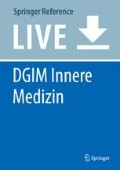Zusammenfassung
Der Diabetes insipidus (Di) entsteht aufgrund eines Mangels an Antidiuretischem Hormon (= Vasopressin, ADH) oder aufgrund einer verminderten Wirkung von ADH am renalen Sammelrohr. Beides führt primär zu einer vermehrten Ausscheidung (Polyurie) eines unkonzentrierten Urins. Dabei bleibt die Natriumkonzentration im Serum in der Regel noch normal, solange der sekundär vermehrte Durst (Polydipsie) die Wasserverluste durch Trinken kompensiert. Sind hingegen auch das Durstgefühl oder die Flüssigkeitsaufnahme gestört, entsteht eine hypernatriäme Dehydration.
Literatur
Czernichow P, Robinson AG (Hrsg) (1985) Diabetes insipidus in man (Buch). Front Horm Res 13. Karger
Fenske W, Allolio B (2012) Clinical review: current state and future perspectives in the diagnosis of diabetes insipidus: a clinical review. J Clin Endocrinol Metab 97(10):3426–3437. https://doi.org/10.1210/jc.2012-1981
Fenske W, Refardt J, Christ-Crain M (2018) Copeptin in the diagnosis of diabetes insipidus. N Engl J Med 379(18):1785–1786. https://doi.org/10.1056/NEJMc1811694
Hensen J, Henig A, Fahlbusch R, Meyer M, Boehnert M, Buchfelder M (1999) Prevalence, predictors and patterns of postoperative polyuria and hyponatraemia in the immediate course after transsphenoidal surgery for pituitary adenomas. Clin Endocrinol 50(4):431–439
Miller M, Dalakos T, Moses AM, Fellerman H, Streeten DH (1970) Recognition of partial defects in antidiuretic hormone secretion. Ann Intern Med 73(5):721–729
Selbsthilfegruppe Netzwerk Hypophysen- und Nebennierenerkrankungen e.V (2015). www.glandula-online.de. Zugegriffen am 01.04.2015
Winzeler B, Cesana-Nigro N, Refardt J, Vogt DR, Imber C, Morin B, Popovic M, Steinmetz M, Sailer CO, Szinnai G, Chifu I, Fassnacht M, Christ-Crain M (2019) Arginine-stimulated copeptin measurements in the differential diagnosis of diabetes insipidus: a prospective diagnostic study. Lancet 394(10198):587–595
Author information
Authors and Affiliations
Corresponding author
Editor information
Editors and Affiliations
Section Editor information
Rights and permissions
Copyright information
© 2020 Springer-Verlag GmbH Deutschland, ein Teil von Springer Nature
About this entry
Cite this entry
Hensen, J. (2020). Diabetes insipidus. In: Lehnert, H. (eds) DGIM Innere Medizin. Springer Reference Medizin. Springer, Berlin, Heidelberg. https://doi.org/10.1007/978-3-642-54676-1_15-2
Download citation
DOI: https://doi.org/10.1007/978-3-642-54676-1_15-2
Received:
Accepted:
Published:
Publisher Name: Springer, Berlin, Heidelberg
Print ISBN: 978-3-642-54676-1
Online ISBN: 978-3-642-54676-1
eBook Packages: Springer Referenz Medizin
Publish with us
Chapter history
-
Latest
Diabetes insipidus- Published:
- 19 March 2020
DOI: https://doi.org/10.1007/978-3-642-54676-1_15-2
-
Original
Diabetes insipidus- Published:
- 02 December 2014
DOI: https://doi.org/10.1007/978-3-642-54676-1_15-1

